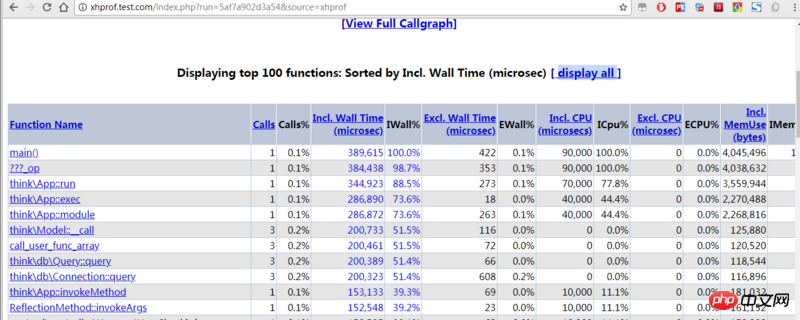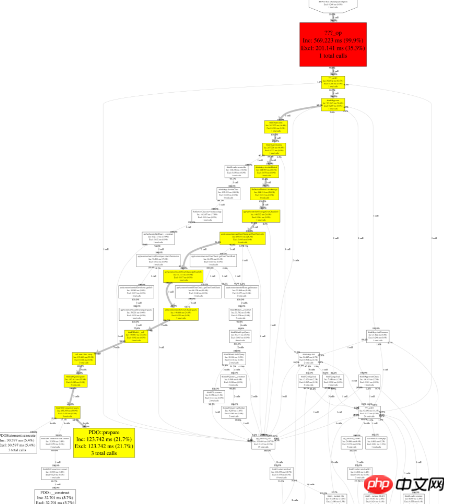 Backend Development
Backend Development
 PHP Tutorial
PHP Tutorial
 Method 1 of using XHProf to analyze PHP performance bottlenecks
Method 1 of using XHProf to analyze PHP performance bottlenecks
Method 1 of using XHProf to analyze PHP performance bottlenecks
Install xhprof extension
wget http://pecl.php.net/get/xhprof-0.9.4.tgz tar zxf xhprof-0.9.4.tgz cd xhprof-0.9.4/extension/ sudo phpize ./configure sudo make sudo make install cd ../
Configure php.ini
[xhprof] extension=xhprof.so xhprof.output_dir=/tmp
Note: xhprof has not been updated for a long time. As of now, it does not support php7. php7 can use https://github. com/phacility/….
Configure xhprof environment
You need to copy the two directories in the xhprof compressed package to the specified directory (assuming it is defined to /work/xhprof/):
mkdir /work/xhprof/ cp -a xhprof_html/ /work/xhprof/ cp -a xhprof_lib/ /work/xhprof/
Then add in the entry file of the project framework:
<div class="code" style="position:relative; padding:0px; margin:0px;"><div class="code" style="position:relative; padding:0px; margin:0px;"><pre class="brush:php;toolbar:false">xhprof_enable(XHPROF_FLAGS_MEMORY | XHPROF_FLAGS_CPU); register_shutdown_function(function() { $xhprof_data = xhprof_disable(); if (function_exists(&#39;fastcgi_finish_request&#39;)){ fastcgi_finish_request(); } include_once "/work/xhprof/xhprof_lib/utils/xhprof_lib.php"; include_once "/work/xhprof/xhprof_lib/utils/xhprof_runs.php"; $xhprof_runs = new XHProfRuns_Default(); $run_id = $xhprof_runs->save_run($xhprof_data, &#39;xhprof&#39;); });</pre><div class="contentsignin">Copy after login</div></div><div class="contentsignin">Copy after login</div></div>Code analysis: $xhprof_data records all function call times and CPU memory consumption during program running. The specific recorded indicators can be controlled through the parameters of xhprof_enable. The currently supported parameters are:
##HPROF_FLAGS_NO_BUILTINS
Skip all built-in (internal) functions.XHPROF_FLAGS_CPU
Adds CPU data to the output performance data.XHPROF_FLAGS_MEMORY
Add memory data to the output performance data.
XHProfRuns_Default, serialize $xhprof_data and save it to a certain directory, you can output the results to the current directory through XHProfRuns_Default(__DIR__). If not specified, xhprof.output_dir## in the php.ini configuration file will be read. #, if still not specified, it will be output to /tmp.
and xhprof_disable appear in pairs, one is at the front of the code running, and the other is at the end. In the middle is the code to be analyzed. After the above configuration, if we subsequently request the project interface, xhprof will analyze the CPU, memory, time consumption, etc. during the request process. The log is saved in the
directory. Configuring web
After configuration, how to check the log? We can build a simple web server:
xhprof.test.com.conf
server {
listen 80;
server_name xhprof.test.com;
root /work/xhprof/xhprof_html;
index index.html index.php;
location ~ \.php$ {
fastcgi_pass 127.0.0.1:9000;
fastcgi_index index.php;
fastcgi_param SCRIPT_FILENAME $document_root$fastcgi_script_name;
include fastcgi_params;
}
}and then configure the virtual host xhprof.test.com. Restart nginx and open xhprof.test.com to see the effect:

 is listed in the default UI :
is listed in the default UI :
- funciton name : Function name
- calls: Number of calls
- Incl. Wall Time (microsec): Function running time (including sub-functions)
- IWall%: Function running time (including sub-functions) proportion
- Excl . Wall Time (microsec): Function running time (excluding sub-functions)
- EWall%: Function running time (excluding sub-functions)
- You can also see the [View Full Callgraph] link on the web. After clicking it, a visual performance analysis graph can be drawn. If an error is reported after clicking, it may be due to a lack of dependency on graphviz. Graphviz is a graph drawing tool that allows you to view performance bottlenecks more intuitively. You can install it if necessary:
yum install -y libpng yum install -y graphviz
Effect:
 Non-intrusive introduction of xhprof
Non-intrusive introduction of xhprof
Previously we implemented the analysis by adding code to the project entry file function. A more elegant way is to create an additional file xhprof.inc.php and save it in the
/work/xhprof/ directory: <div class="code" style="position:relative; padding:0px; margin:0px;"><div class="code" style="position:relative; padding:0px; margin:0px;"><pre class="brush:php;toolbar:false">xhprof_enable(XHPROF_FLAGS_MEMORY | XHPROF_FLAGS_CPU);
register_shutdown_function(function() {
$xhprof_data = xhprof_disable();
if (function_exists(&#39;fastcgi_finish_request&#39;)){
fastcgi_finish_request();
}
include_once "/work/xhprof/xhprof_lib/utils/xhprof_lib.php";
include_once "/work/xhprof/xhprof_lib/utils/xhprof_runs.php";
$xhprof_runs = new XHProfRuns_Default();
$run_id = $xhprof_runs->save_run($xhprof_data, &#39;xhprof&#39;);
});</pre><div class="contentsignin">Copy after login</div></div><div class="contentsignin">Copy after login</div></div>Use the automatic loading function of PHP before executing the code Inject this file, edit php.ini:
auto_prepend_file = /work/xhprof/xhprof.inc.php
and then restart the PHP service. This will take effect for everyone using this php environment.
Or you can also write it into the nginx configuration of the specified project:
jifen.cc.conflocation ~ \.php$ {
fastcgi_pass 127.0.0.1:9000;
fastcgi_index index.php;
fastcgi_param SCRIPT_FILENAME $document_root$fastcgi_script_name;
fastcgi_param PHP_VALUE "auto_prepend_file=/work/xhprof/xhprof.inc.php";
include fastcgi_params;
}Then restart the nginx service. This only takes effect for this project.
Files included via auto_prepend_file and auto_append_file will be parsed in this mode, but there are some restrictions, such as functions must be defined before being called.
Modify the sampling frequency
By default, xhprof will run every time. If the online environment is set like this, it will have an impact on performance.
xhprof.inc.php
<?php
$profiling = !(mt_rand()%9);
if($profiling) xhprof_enable(XHPROF_FLAGS_MEMORY | XHPROF_FLAGS_CPU);
register_shutdown_function(function() use($profiling) {
if($profiling){
$xhprof_data = xhprof_disable();
if (function_exists('fastcgi_finish_request')){
fastcgi_finish_request();
}
include_once "/work/xhprof/xhprof_lib/utils/xhprof_lib.php";
include_once "/work/xhprof/xhprof_lib/utils/xhprof_runs.php";
$xhprof_runs = new XHProfRuns_Default();
$xhprof_runs->save_run($xhprof_data, 'xhprof');
}
});Summary
In this article, we introduced how to analyze PHP performance based on xhprof extension, record it in the log, and finally use The UI that comes with the xhprof extension is displayed on the web. Main knowledge points:
- Install xhprof extension
- Inject xhprof into the application
- Based on nginx Display analysis results
- The above is the entire content of this article. I hope it will be helpful to everyone’s study. For more related content, please pay attention to the PHP Chinese website!
Related recommendations:
Notes on php-fpm parameter configuration of php7The above is the detailed content of Method 1 of using XHProf to analyze PHP performance bottlenecks. For more information, please follow other related articles on the PHP Chinese website!

Hot AI Tools

Undresser.AI Undress
AI-powered app for creating realistic nude photos

AI Clothes Remover
Online AI tool for removing clothes from photos.

Undress AI Tool
Undress images for free

Clothoff.io
AI clothes remover

Video Face Swap
Swap faces in any video effortlessly with our completely free AI face swap tool!

Hot Article

Hot Tools

Notepad++7.3.1
Easy-to-use and free code editor

SublimeText3 Chinese version
Chinese version, very easy to use

Zend Studio 13.0.1
Powerful PHP integrated development environment

Dreamweaver CS6
Visual web development tools

SublimeText3 Mac version
God-level code editing software (SublimeText3)

Hot Topics
 PHP 8.4 Installation and Upgrade guide for Ubuntu and Debian
Dec 24, 2024 pm 04:42 PM
PHP 8.4 Installation and Upgrade guide for Ubuntu and Debian
Dec 24, 2024 pm 04:42 PM
PHP 8.4 brings several new features, security improvements, and performance improvements with healthy amounts of feature deprecations and removals. This guide explains how to install PHP 8.4 or upgrade to PHP 8.4 on Ubuntu, Debian, or their derivati
 How To Set Up Visual Studio Code (VS Code) for PHP Development
Dec 20, 2024 am 11:31 AM
How To Set Up Visual Studio Code (VS Code) for PHP Development
Dec 20, 2024 am 11:31 AM
Visual Studio Code, also known as VS Code, is a free source code editor — or integrated development environment (IDE) — available for all major operating systems. With a large collection of extensions for many programming languages, VS Code can be c
 Explain JSON Web Tokens (JWT) and their use case in PHP APIs.
Apr 05, 2025 am 12:04 AM
Explain JSON Web Tokens (JWT) and their use case in PHP APIs.
Apr 05, 2025 am 12:04 AM
JWT is an open standard based on JSON, used to securely transmit information between parties, mainly for identity authentication and information exchange. 1. JWT consists of three parts: Header, Payload and Signature. 2. The working principle of JWT includes three steps: generating JWT, verifying JWT and parsing Payload. 3. When using JWT for authentication in PHP, JWT can be generated and verified, and user role and permission information can be included in advanced usage. 4. Common errors include signature verification failure, token expiration, and payload oversized. Debugging skills include using debugging tools and logging. 5. Performance optimization and best practices include using appropriate signature algorithms, setting validity periods reasonably,
 PHP Program to Count Vowels in a String
Feb 07, 2025 pm 12:12 PM
PHP Program to Count Vowels in a String
Feb 07, 2025 pm 12:12 PM
A string is a sequence of characters, including letters, numbers, and symbols. This tutorial will learn how to calculate the number of vowels in a given string in PHP using different methods. The vowels in English are a, e, i, o, u, and they can be uppercase or lowercase. What is a vowel? Vowels are alphabetic characters that represent a specific pronunciation. There are five vowels in English, including uppercase and lowercase: a, e, i, o, u Example 1 Input: String = "Tutorialspoint" Output: 6 explain The vowels in the string "Tutorialspoint" are u, o, i, a, o, i. There are 6 yuan in total
 How do you parse and process HTML/XML in PHP?
Feb 07, 2025 am 11:57 AM
How do you parse and process HTML/XML in PHP?
Feb 07, 2025 am 11:57 AM
This tutorial demonstrates how to efficiently process XML documents using PHP. XML (eXtensible Markup Language) is a versatile text-based markup language designed for both human readability and machine parsing. It's commonly used for data storage an
 Explain late static binding in PHP (static::).
Apr 03, 2025 am 12:04 AM
Explain late static binding in PHP (static::).
Apr 03, 2025 am 12:04 AM
Static binding (static::) implements late static binding (LSB) in PHP, allowing calling classes to be referenced in static contexts rather than defining classes. 1) The parsing process is performed at runtime, 2) Look up the call class in the inheritance relationship, 3) It may bring performance overhead.
 What are PHP magic methods (__construct, __destruct, __call, __get, __set, etc.) and provide use cases?
Apr 03, 2025 am 12:03 AM
What are PHP magic methods (__construct, __destruct, __call, __get, __set, etc.) and provide use cases?
Apr 03, 2025 am 12:03 AM
What are the magic methods of PHP? PHP's magic methods include: 1.\_\_construct, used to initialize objects; 2.\_\_destruct, used to clean up resources; 3.\_\_call, handle non-existent method calls; 4.\_\_get, implement dynamic attribute access; 5.\_\_set, implement dynamic attribute settings. These methods are automatically called in certain situations, improving code flexibility and efficiency.
 PHP and Python: Comparing Two Popular Programming Languages
Apr 14, 2025 am 12:13 AM
PHP and Python: Comparing Two Popular Programming Languages
Apr 14, 2025 am 12:13 AM
PHP and Python each have their own advantages, and choose according to project requirements. 1.PHP is suitable for web development, especially for rapid development and maintenance of websites. 2. Python is suitable for data science, machine learning and artificial intelligence, with concise syntax and suitable for beginners.





